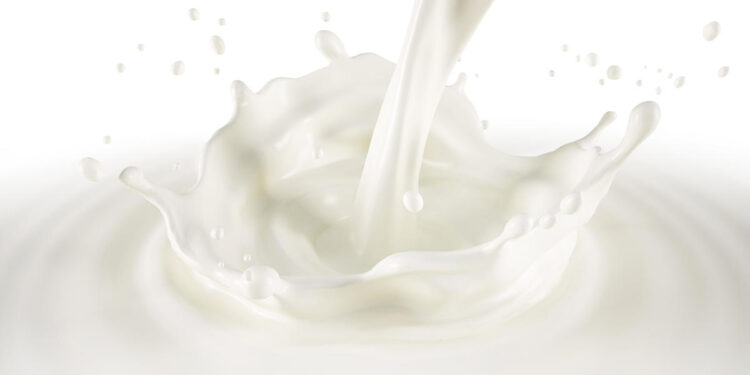A “small however detectable amount” of infectious H5N1 chook flu The virus was in a position to survive a typical strategy to pasteurizing milk, in keeping with new analysis co-authored by scientists on the Nationwide Institutes of Well being.
The findings: published Friday in The New England Journal of Medication, had been based mostly on experiments run on the company's lab. The researchers word this isn’t the identical as discovering the infectious H5N1 virus in milk from grocery shops.
Up to now, officers haven’t detected the infectious virus in any grocery store milk samples.
The discovering comes as authorities are nonetheless figuring out new infected herds on this yr's unprecedented outbreak of H5N1 chook flu in dairy cattle.
Infections have been detected in cows throughout farms in no less than a dozen states, with many of the constructive checks coming from uncooked milk samples that had been teeming with the virus. Authorities have referred to as on states to curb uncooked milk gross sales that might unfold the virus, and have warned customers towards consuming uncooked milk,
“The examine mirrored experimental circumstances, and shouldn’t be used to attract any conclusions concerning the security of the US milk provide,” a Meals and Drug Administration spokesperson stated in a press release.
In the actual world of business dairy processing, milk from infectious cows is probably going being combined with milk from wholesome cows, diluting the virus and making it much less doubtless there can be sufficient of it to outlive. Technical particulars of how the milk is pasteurized, in addition to further steps to deal with the milk, additionally minimize the chance. Pasteurization entails treating the milk at excessive temperatures for a time frame to kill contamination.
Outcomes from earlier FDA research of 297 samples of retail dairy merchandise like milk and yogurt didn’t flip up any infectious virus. Earlier checks discovered only some innocent fragments of the virus left over from pasteurization.
Experimental laboratory circumstances
“These are roughly experimental laboratory circumstances. And we predict that mechanical pasteurization in dairy farming will most likely be simpler than what we do,” stated Vincent Munster, chief of the virus ecology unit on the Nationwide Institute of Allergy and Infectious Illnesses.
Munster's lab in Montana has carried out work for years finding out the power of viruses to remain infectious in numerous circumstances, together with earlier work pasteurizing pathogens in milk, like from an outbreak of coronaviruses in camels from Jordan,
On this examine, they checked out two approaches of pasteurization, examined on milk with concentrations of H5N1 they added at ranges much like what has been seen from some extremely infectious cows.
One pasteurization technique they checked out heated milk to 72 levels Celsius (about 161 levels Fahrenheit) for 15 seconds, much like the “high temperature short time” technique that’s used broadly throughout the dairy trade. That yielded milk with what Munster stated nonetheless had “minute quantities of infectious virus.”
“You're actually speaking about like 10 virus particles, whereas the preliminary beginning dose can be one thing like 10 million or 100 million virus particles,” stated Munster.
He additionally pointed to variations between the lab examine and real-world trade practices which give industrial milk pasteurization a step up towards the virus.
“There may be an preliminary interval within the dairy milk pasteurization that the milk must get from let's say 4 levels to 72 levels (Celsius). And clearly as soon as it begins hitting round 56 levels, it already begins inactivating the virus,” he stated.
The second pasteurization strategy — a half hour at 63 levels Celsius — was simpler. The infectious virus was undetectable inside minutes, lengthy earlier than pasteurization was over.
“Pasteurization strategies had been developed to really cut back the quantity of viable micro organism in milk to lengthen fridge life, so to talk. And so they're not essentially initially designed to inactivate viruses,” stated Munster.
Pasteurizing milk longer or at hotter temperatures
Munster thinks that even including 5 to 10 extra seconds of pasteurization may supply the dairy trade a “security buffer,” guaranteeing that there's no energetic virus leftover in milk even when their uncooked milk provide seems to have higher concentrations of infectious virus than the lab's.
“When you actually need to make 100% positive there's no energetic virus, rising the period even by like 5 to 10 seconds of pasteurization would assist you to truly improve that security margin,” Munster stated.
However an FDA spokesperson stated that their testing knowledge to date reveals the pasteurization processes utilized by US dairy corporations are efficient at killing H5N1. Many corporations “use temperatures which can be higher, typically a lot higher than the minimal requirements,” the spokesperson stated, and gear that extra constantly heats milk.
“(T)he United States would hesitate to alter pasteurization parameters with out knowledge to exhibit a public well being want,” the spokesperson stated, warning that altering the requirements would have an effect on the flavour of dairy merchandise.
The company has to date not launched outcomes from its personal examine to validate the pasteurization of uncooked milk for H5N1, first introduced earlier this yr. Final month, it cited “the totality of the proof” in reiterating that “the industrial milk provide is secure.”
The spokesperson stated the FDA's examine “is a prime precedence for the company” and that they had been working to share the ends in the close to future. The company is seeking to validate “real-world processing circumstances” with gear utilized in industrial amenities.
“Sound science is essential to informing public well being choices like these made by the FDA associated to meals security and we take this present scenario and the protection of the milk provide very critically,” the spokesperson stated.
Munster stated the FDA and the US Division of Agriculture even have research pasteurization, amongst numerous teams which have confirmed heating up milk is usually in a position to totally inactivate the menace from H5N1 virus.
“Fortuitously, they do truly inactivate viruses very properly. However I feel the main focus level needs to be two fold: ensuring that pasteurization is as much as the duty we're asking from it, and the info means that it’s, but in addition that we must always reduce any H5N1 constructive milk truly coming into these dairy pasteurization,” he stated.




